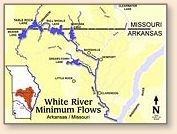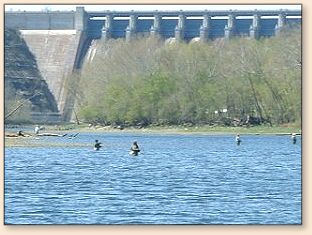|
In case you haven't heard, the way the world
famous White River of Arkansas and Missouri
and the five large lakes that comprise the
White River Chain of Lakes are managed is
currently being re-thought by policymakers at
the federal and state level. The controversy
centers on what is called the "Minimum Flow
Initiative." If you fish the White River,
Beaver Lake, Table Rock Lake, Bull Shoals Lake,
or Greer's Ferry Lake; if you reside along the
shores of the same; or if you operate a business
along the same shores; then you would be well
served to educate yourself on this proposition
and develop an opinion as to whether you are for
or against it. Many stakeholders have already
weighed in on the matter, and there has been a
running debate among the river system's anglers
for the past couple of years. Currently, the
public comment period is open with the US Army
Corps of Engineers. Concerned parties should
contact the Little Rock District Office.
According to the Water Resources Development Act
of 1999 and 2000, Congress has authorized the US
Army Corps of Engineers to:
Allocate a small portion of the water in
each of the following White River Chain of Lakes
reservoirs for the purpose of establishing minimum
flows: Beaver Lake, Table Rock Lake, Bull Shoals
Lake, and Greer's Ferry Lake.
Determine if said minimum flows were technically
feasible, environmentally acceptable, and economically
justified.
Report their findings back to Congress before
making any modifications to the water resource plans
in order to accommodate minimum flow.
 Minimum flow is the planned release of small amounts
of water when no water is being released from the dams
for the purposes of hydropower generation or flood
control. Under the plan, minimum flows would be
released about six months out of the year. The
timing of minimum flow releases would vary from
dam to dam depending on what was determined to
best impact the watershed as a whole.
Minimum flow is the planned release of small amounts
of water when no water is being released from the dams
for the purposes of hydropower generation or flood
control. Under the plan, minimum flows would be
released about six months out of the year. The
timing of minimum flow releases would vary from
dam to dam depending on what was determined to
best impact the watershed as a whole.
What is to be gained from minimum flows?
Increased forage production of the river
system would provide for more food for trout and
other game fish.
Lower Summer time water temperatures and
improved Dissolved Oxygen content for the river
system.
Improved navigation over shoals.
There is no clear answer to the opposing question:
what would be lost to minimum flows? But arguments
have ranged from wading the tailwaters becoming more
hazardous to increased boat traffic and the
possibility of a resultant negative environmental
impact on the fishery due to increased pressure.
It seems to me that wading access will most likely
be gained in some areas and lost in others, which
may balance itself out or break in favor of either
more or less access. The formal environmental
impact study due out later this year should tell
us more based on GIS modeling which should accompany
the report. With improved navigability, undoubtedly
there will be stretches of the river now favored by
wade fishermen that will see more boat traffic, but
just how this would harm the fishery overall has not
been convincingly established by the opposition.
Water allocations to support minimum flows range
from 1.5 surface feet to 5.0 surface feet from each
of the five lakes. This amounts to between three
and four percent of the total allocated water storage
of each lake. Measured in cubic feet per second (cfs),
the increase ranges from 81 to 590 cfs below each dam.
Add this to the leakage rate of each dam and the
resultant flow rates increase to 136 cfs to 800 cfs.
Even at 800 cfs, the tailwaters would all still be
highly wadable. See the before and after minimum
flow pictures below for the White River just below
Bull Shoals Dam, which is both the most contested
site and the one with the highest flow rate of 800
cfs.

Many area anglers wade below these dams on one full
generator, which has a discharge rate of 3,000 cfs.
When Bull Shoals Dam (pictured above) is generating
at full power, the discharge rate surges to 24,000
cfs.
While the proposal has detractors among anglers,
the principal naysayer is the Southwest Power
Administration, who could potentially be forced
to bear some of the costs associated with the
project. However, according to the Arkansas Game
and Fish Commission, there is no research that
predicts any increase in the costs of electrical
production that would be passed on to the consumers.
Various cost-sharing initiatives and mitigation
proposals are being researched and sought out which
could even negate if not offset the costs of
re-tooling some of the dams.
There seems to be far more diversity of opinion
among the stakeholders on the Arkansas side of
the border (anglers in particular) than on the
Missouri side. Both the Arkansas Game and Fish
Commission and the Missouri Department of
Conservation are in favor of the plan. And public
opinion on the Missouri side is relatively homogenous
in support of the initiative. One could summarize
the Arkansas sentiment as being somewhat divided
along wade-anglers versus lodge operators, guide
services, and boat rental proprietors; or even
as bait/float fishermen versus fly fishermen.
However, many Arkansas fly anglers support the
plan. One of the most outspoken critics continues
to be Fox Statler, a well-known fly tier, angler,
and outdoor writer from Arkansas. Statler basically
contends that wading will become more difficult and
environmental benefits will not likely be realized
to the extent they are predicted to by the
protagonists. He has written widely on the subject
over the past year, and continues to campaign against
minimum flow at public meetings and on Internet bulletin
boards.
I'm unaware of a Missouri counterpart to Mr. Statler.
Up here, everyone from the most disenfranchised fly
angler to the outfitters, guides, and boat rental
shops all look forward to the day when minimum flow
is enacted. Missouri's most outspoken protagonist
is probably Phil Lilley, owner of Lilley's Landing,
a trout resort on the shores of Lake Taneycomo in
Branson.
 Everything I have read and heard suggests that
what we would experience would generally be an
increase of from 10" to 18" of water depth in
the tailwater sections of the White River and
a few hundred more cubic feet per second of flow
rate. Here on Lake Taneycomo, that possibility
is almost universally welcomed by float and wade
anglers alike. Especially during the Fall and
Spring of the year on Lake Taneycomo's Trophy
Management Zone (the tailwater below Table Rock
Dam seen here), we often experience periods of no
flow that measure into weeks. During such times
there is no current in the shallow, two-mile long
tailwater fishery. This can make fly fishing in
particular somewhat more difficult. It is my
opinion that some of the very best fly-fishing
is to be had when the dam is generating one
generator. Minimum flow would roughly duplicate
that water condition. As for the additional 10"
to 18" of water, it is still too little to provide
much greater boat access to the upper lake. However,
it would dramatically increase the amount of submerged
gravel beds where the vital food sources for trout
breed and live. Logic dictates that more habitat
equals more food, and more food equals bigger fish...
or more fish...or both.
Everything I have read and heard suggests that
what we would experience would generally be an
increase of from 10" to 18" of water depth in
the tailwater sections of the White River and
a few hundred more cubic feet per second of flow
rate. Here on Lake Taneycomo, that possibility
is almost universally welcomed by float and wade
anglers alike. Especially during the Fall and
Spring of the year on Lake Taneycomo's Trophy
Management Zone (the tailwater below Table Rock
Dam seen here), we often experience periods of no
flow that measure into weeks. During such times
there is no current in the shallow, two-mile long
tailwater fishery. This can make fly fishing in
particular somewhat more difficult. It is my
opinion that some of the very best fly-fishing
is to be had when the dam is generating one
generator. Minimum flow would roughly duplicate
that water condition. As for the additional 10"
to 18" of water, it is still too little to provide
much greater boat access to the upper lake. However,
it would dramatically increase the amount of submerged
gravel beds where the vital food sources for trout
breed and live. Logic dictates that more habitat
equals more food, and more food equals bigger fish...
or more fish...or both.
But, for me, one of the most attractive elements of
the whole proposition is that minimum flow would
restore the entire river system to
a more natural state - as a river.
Rivers flow. What we currently have is a chain
of lakes that sometimes flow like raging rivers
and other times are still and silent. Perhaps
it is mere sentimentality or some romantic notion
on my part, but that's the way I feel about it.
I think the entire argument is summarized in that
one statement. We dammed the rivers and created
the lakes. Now we have wonderful lakes. But we
have lost much of what was once one of the greatest
rivers in the United States. Minimum flow would
go a long way toward restoring as much of that
river as is recoverable to "river status." While
it will not restore the glory days of the
eighteen-day float fishing trips or the hundreds
of miles of prime Smallmouth Bass habitat, it will
guarantee us that the river will flow again. It
will also undoubtedly improve the aquaculture for
the trout that have replaced those bass we lost to
the construction of the dams. If you will allow
me the pun, I encourage all stakeholders to "go
with the flow." ~ Ken
About Ken:
Ken graduated from Southern Methodist University
in 1988, and spent the next several years serving
in the United States Navy as an intelligence analyst
and Russian Language translator. He is a veteran
of Desert Shield and Desert Storm. Leaving the
nation's service in 1993.
Ken is also a published outdoor writer and historian,
having penned articles and stories that have appeared
in several national hunting publications like North
American Hunter magazine, on GunMuse.com, in regional
and local newspapers, and historical and literary
journals. He also provides hunting and dog training
seminars for Bass Pro Shops and other sporting goods
retailers nationwide and works with other outdoors
businesses and conservation organizations in the
fields of public relations, promotional marketing,
fund-raising, and advertising. He also is a partner
in Silver Mallard Properties, LLC. He currently
resides with his wife, Wilma, their Weimaraner,
Smoky Joe, and their Labrador Retriever, Jake, in
Branson, Missouri, where he founded the
Branson/Tri-Lakes Chapter of Ducks Unlimited in 1998.
|



